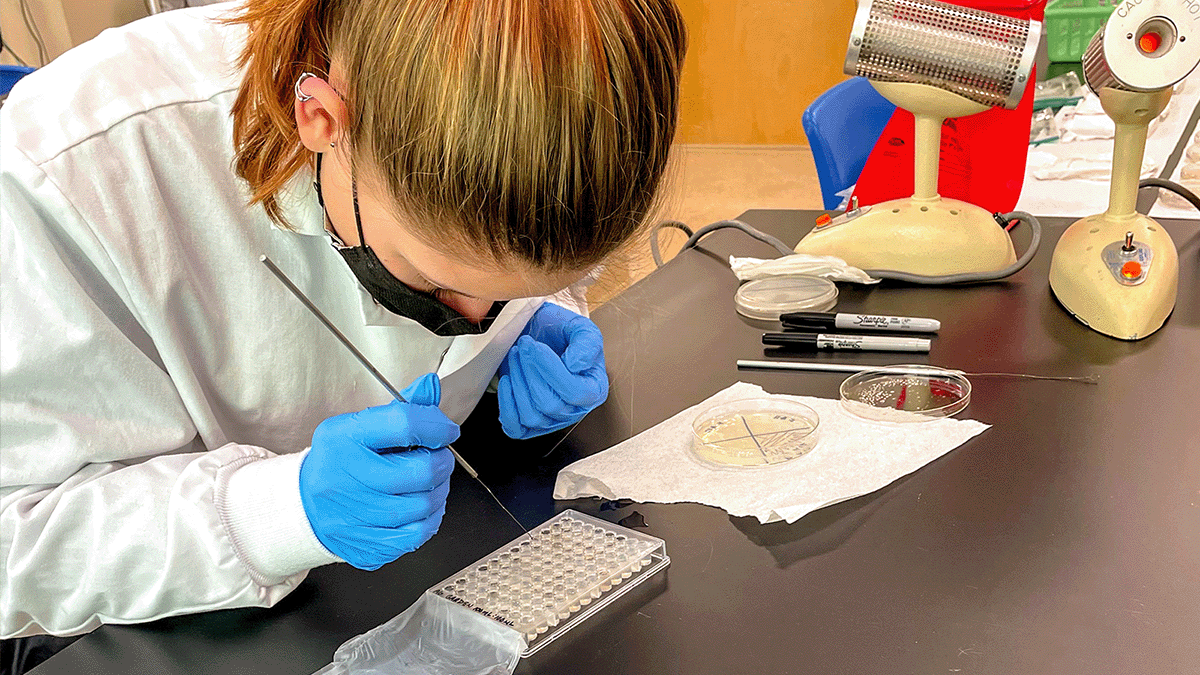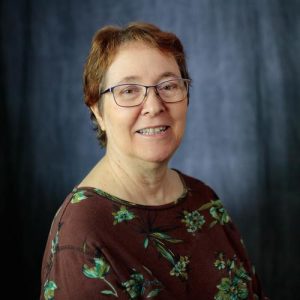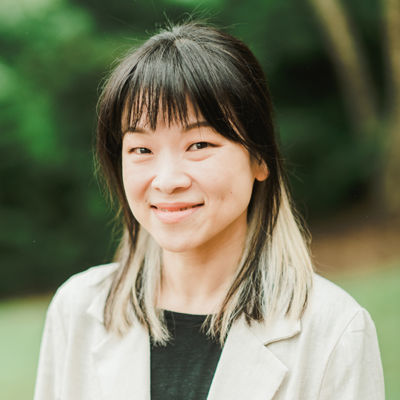
Incorporating eDNA Curricula in Undergraduate Education Across Maine
By Ilaria Bardini, Writing Intern
The many applications of environmental DNA (eDNA) in research and conservation has inspired educators to find ways to implement such topics into their various curricula. As an emerging appliance, eDNA can allow researchers and stakeholders to track population fluctuations of keystone species in order better understand the impacts of climate change on natural environments, as well as to assist with the detection of harmful pathogens. The aid of Maine-eDNA Undergraduate Curriculum Innovation Seed grants has allowed educators across the state of Maine to develop eDNA based curriculum to engage their students with these new scientific techniques. Two educators developing integrated eDNA courses are Judith Roe, at the University of Maine Presque Isle (UMPI), and Yi Jin Gorske at Saint Joseph’s College.
Judith Roe, Associate Professor of Biology at UMPI, developed a project-based eDNA curriculum for undergraduate genetics, ecology, and environmental science classes. With 10 years experience at UMPI, Roe specializes in medicinal plant barcoding and the genetic identification of snails and birds. Roe works with David Putnam, a UMPI associate professor of science, and Jason Johnston, a UMPI Associate Professor of Ecology, to develop course content.
The course modules are designed for General Biology Laboratory 1 and 2, as well as Genetics, Ecology, and an independent study. Roe is developing an inclusive, cross-skill-level curriculum to engage students from multiple backgrounds to be implemented in classroom, field, and laboratory settings. “At the introductory level, some students don’t even know what taxonomy is. It gives you opportunities to provide context for introductory concepts.” Roe explained, “In upper level classes, you can get into the depth of topics and learning outcomes.”
eDNA is used in a multitude of ecologically, environmentally, and economically important ways, as Roe explained, “I started using eDNA in research projects, characterizing species of snails and bird feces. Then I realized that eDNA is something that could be accessible for students,” and undergraduate exposure to these new techniques is an important way to ensure a strong basis in genetic skills and knowledge. “eDNA allows us to determine past species presence without having to see them, only using genetics,” Roe said. With ideas to use eDNA approaches for several marine and microbial projects, Roe began developing eDNA course modules.
In the fall of 2022, Roe conducted the first implementation of eDNA techniques in General Biology Labs (BIO 112) on the topic of soil microbiomes. Starting in the 1920s, arsenical pesticides and herbicides were used to treat pests such as apple moth caterpillars and various insects. Lead, copper, and sodium arsenate were used liberally for the farming of apples, blueberries, and potatoes in New England. Long-term exposure to these chemicals result in elevated cancer risks, which are associated with the historical use of arsenical pesticides and the use of dug wells for drinking water. “We want to know more about where the pesticides were used during the 1920s through the 1950s. Unlike our water, there aren’t any arsenic standards for soil in Maine.” Roe remarked, describing the goals for the BIO 112 lab.
The beginning of the course covered rudimentary topics like the definition of a microbiome and a discussion of what makes soil healthy. “This is a place where you can bring in different perspectives.” Roe expanded. “You can have someone from a soil science class, or from someone involved in plant growth research.” Students investigated questions regarding the importance of soil health, species of bacteria and fungi present in soil samples, arsenic levels across sampling locations, and the effects of arsenical pesticides on the soil microbiome.
Students collected small samples in Aroostook County with locations at a farm owned by Randy Martin, UMPI’s community garden, and Houlton High School’s orchard. Once collected, each was tested to determine respective arsenic levels. With the use of Qiagen PowerSoil Kits, students used centrifugation techniques in eDNA extraction for each sample, which were then sent to CosmosID for species identification. “Many students were surprised by how many fungi were in their 0.25 gram sample of soil.” Roe said. “Many guessed there would be two or three species but when they saw the data, they were astonished by the immense number of species of bacteria and fungi.” Through the use of data visualization, a highly emphasized topic in BIO 112, students studied the presence of Glomeromycota at each sample site. Glomeromycota is an integral monophyletic group, meaning descended from a single ancestor, of fungi that form mutualistic relationships with the roots of many plant species. When analyzed, their presence was low in potato fields and 66 percent of the orchard samples. Nearing the end of the semester, students were asked to pick a bacterial or fungal species present in the samples, conduct literary research, and give a presentation on their respective findings.
Roe continues to develop curriculum modules with plans to introduce eDNA approaches into an introductory environmental science course at UMPI as well as develop a wood turtle eDNA project. Roe stated, “The most rewarding part of developing these course modules is using genetics in a new way to study environmental problems. I am very fortunate to be able to share my discoveries with students and with the broader scientific community.” With goals to further the dissemination of these eDNA course modules, Roe hopes to introduce more undergraduate students to the capabilities of these novel techniques with the aid of Maine-eDNA Curriculum Seed Grant Funding.
Yin Jin Gorske at Saint Joseph’s College in Standish, Maine, works under a Maine-eDNA Education Seed grant to develop undergraduate curriculum for a Course-based Undergraduate Research Experience (CURE) class. Gorske, an assistant professor in the Department of Natural Science, teaches organic and medicinal chemistry, with research interests in drug discovery projects. Working with other faculty, Gorske developed Biology (BIO) 309: “Culture-independent methods to discover natural products produced by soil bacteria,” a multi-disciplinary CURE class that aimed, as Gorske explained, “to model an authentic research team environment, reflective of how research happens in real life. While we have some opportunities to do faculty-student research, there is a limit.” With the knowledge that some students do not have the ability to otherwise participate in research, Gorske wanted to provide a transformative experience that would allow them to think deeply about their level of interest and curiosity with science.
Utilizing a team-based structure, members of the class worked together in most elements of the course, from soil sample collection to the creation of a scientific podcast. Each of the five undergraduates enrolled has different backgrounds, interests, and skill sets in biology, chemistry, or ecology, as they worked together to create a space to conduct scientific research on the microbiome of Maine’s soil. With one lecture and two labs per week, the class was heavily experience based, lending itself to opportunities for learning and building experimentation and skill sets in a lab environment. “With a class of five students, the ability to explore and utilize the different strengths present in laboratory settings and other components of the course was valuable.” Gorske added.
Students obtained aseptic, contaminant-free soil samples from four separate locations on the Saint Joseph’s College campus with two replicates per location to ensure more accurate test results. The samples were brought to the lab for testing and analysis. Once the samples were safely in the lab, observably thriving colonies of microorganisms were extracted and allowed to grow in SMS media, a nutrient dense broth ideally suited for the promotion of colony replication. Students then observed the fermented test tubes for signs of colony growth and the consequential presence of metabolites, which govern soil bacteria’s production and ecological function.“We wanted access to those metabolites to see whether those compounds would be active against bacterial species,” Gorske explained. With the use of eDNA, the students were able to genetically characterize microorganisms in the soil samples that produce antimicrobial growth inhibitors for harmful bacteria. Through the process of working with these microorganisms, students investigated questions such as “Are the compounds we’re isolating toxic across the board or perform a specific function?” and “Are these compounds active against other strains of bacteria?” The colonies were then tested against E. coli, M. smegmatis, and S. aureus, of which the latter two are bacteria that cause skin infections. Although some strains of E. coli are necessary for our body to digest food, other strains cause harmful contagious infections. Through their lab work, students discovered that one microbial colony had the ability to inhibit S. aureus, while another could inhibit both E. coli and S. aureus.
Over the course of the semester, students were assessed in a variety of ways that focused on collaborative demonstrations of knowledge. Students were asked to write manuscripts, create podcasts, turn in their final individual lab notebooks, and engage in feedback and editorial processes. As a multidisciplinary method of showcasing their research, students were asked to create a podcast with seven episodes on relevant topics related to their research experience in BIO 309. Through conducting interviews, writing episode scripts, and learning audio production processes, students were able to explore a new method of scientific communication. “Listening to the students’ podcasts was the most rewarding aspect of teaching this course. There was editing and music, and it was wonderful to see the way they were able to engage in a different way of describing their research,” Gorske remarked. Several scientists from NovaBiotics working on closely related research topics agreed to be interviewed. Amy Spoering, Director of Biological Research at NovaBiotics, participated in the final podcast. “She was the lead microbiologist for the paper that we adapted for the project.” Gorske explained, “For this podcast, she gave a fantastic overview on drug discovery using natural products and focused specifically on her work at Novabiotics.” Once the podcasts were done, they were shared with members of the Saint Joseph’s community. “Creating and sharing their podcasts showed the students that what they were working on is real, it matters, and that there is a whole company devoted to it.”
Gorske plans to further develop the partnership with NovaBiotics and extend the scope and duration of the course. “Because this course laid such a good foundation for the future of BIO 309, I expect to pick up the pace of the data collection and analysis process.” With more time to focus on the analysis of their results, the students would be able to ask more questions, push their projects, and be able to present their findings to the greater scientific community. “Seeing how the students dealt with challenges and confusing results was inspiring,” Gorske said, emphasizing the importance of undergraduate research experiences. Creating spaces for students to engage in eDNA exploration is an essential aspect of developing the future STEM workforce. With the help of seed grants, educators are able to expose budding researchers to the capabilities of these essential tools made possible with the use of eDNA.


